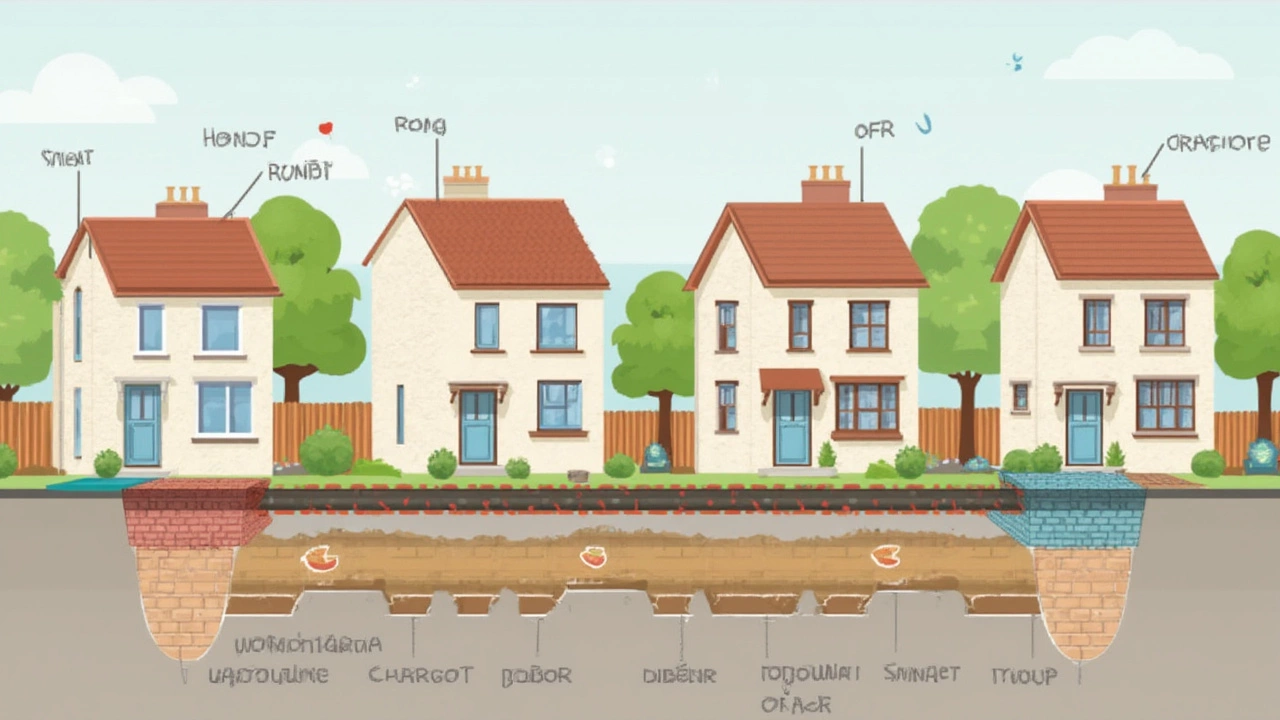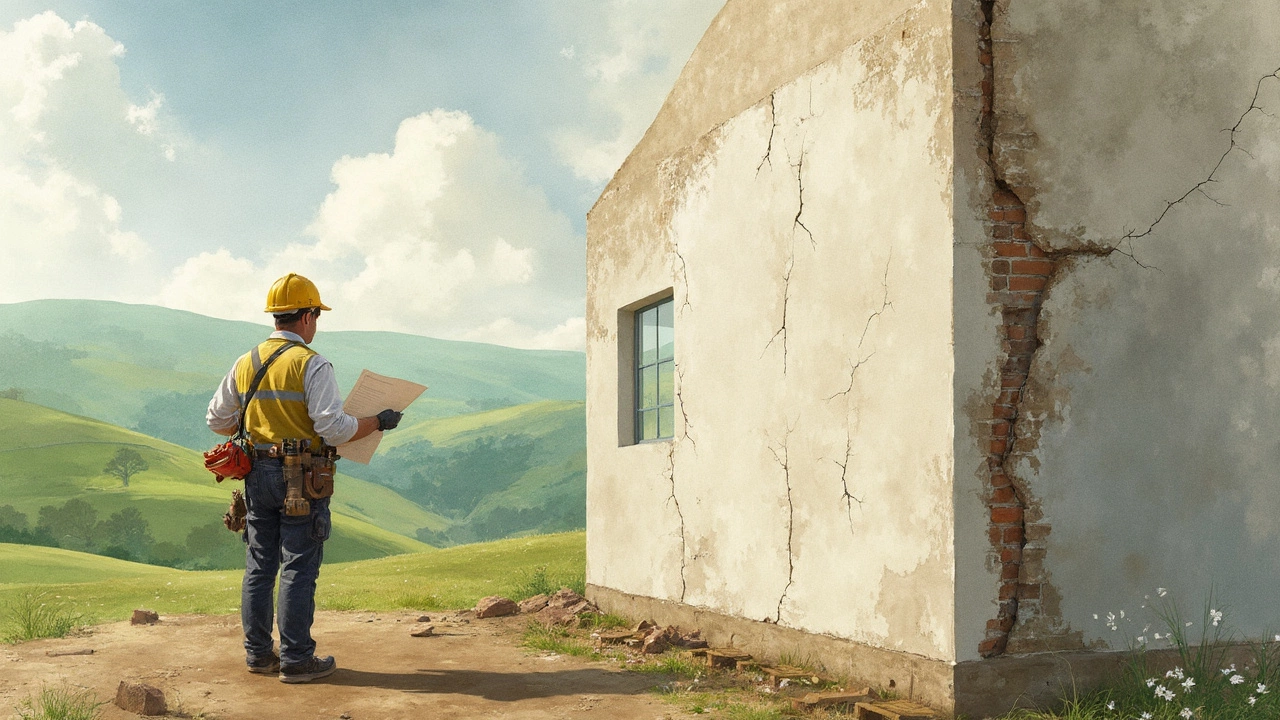So you’ve got yourself a shiny new house, and everything seems perfect. But wait, why are there cracks appearing on the walls already? Don’t panic just yet—cracks in new builds are pretty normal. They might be annoying, but they’re usually not a reason to freak out.
First off, let’s talk about why these cracks happen. Most of the time, they’re because your new home’s settling in. Think of it like breaking in a new pair of shoes. The ground and materials expand and contract with temperature changes, and that’s a big part of why you might see a few lines here and there.
Now, not all cracks are created equal. Some are like those little scratches on your car’s paint — annoying but harmless. Others, though, can be a big deal. Knowing which is which can save you a lot of future headaches. Stick around to get the lowdown on what to look for and how to handle it.
- Understanding Why Cracks Occur
- Types of Cracks You Might See
- Spotting Serious Structural Concerns
- Practical Tips for Prevention and Repair
- When to Call in the Experts
Understanding Why Cracks Occur
Starting to notice little cracks in your brand-new home? It might feel like a nightmare, but hang on a minute—let’s dig into why this happens. New builds often experience cracks due to a process called settling. When a house is first constructed, the soil beneath it begins adjusting to the weight of the structure. This can cause slight movements in the building's foundations, leading to visible cracks.
Another big player in this cracking game is temperature. As temperatures vary, especially in regions that experience big swings from hot to cold, the materials used in construction—like wood, drywall, and concrete—expand and contract. This seasonal movement can also result in some minor cracking, typically nothing to lose sleep over, but definitely something to keep an eye on.
Then there’s moisture. Homes are constantly exposed to various levels of humidity and moisture. If you’ve got too much water around your foundation or walls, it might creep into the structure, leading to cracks. This is especially true for new builds since the materials are still drying out and stabilizing in their new environment.
A lot of new homeowners ask whether the material choice makes a big difference. The answer is yes! Brick and concrete tend to crack more visibly, while wooden structures might hide cracks better initially but show signs of warping over time. This is just part of how these materials naturally behave under pressure and over time.
Understanding these basic principles helps you know what’s normal and what needs fixing. To help illustrate just how normal some shifting can be, here's a simple table with expected settling times:
| Material | Settling Time |
|---|---|
| Brick | 1-3 years |
| Concrete | Up to 2 years |
| Wood Frames | 1-2 years |
Now that you know why these cracks happen, you’re better equipped to handle them without unnecessary stress. Next up, we’ll cover what types of cracks you might see and how to spot the ones that really matter.
Types of Cracks You Might See
Okay, so you’re spotting cracks in your new build, and you’re wondering what they mean. Let’s break it down. Cracks can show up in a bunch of places, and they can tell you different things about the house. Knowing if they’re just cosmetic or a sign of a deeper issue is key.
First up, those tiny hairline cracks. These are super thin and usually show up around doors or windows. They often happen due to normal settling and rarely mean anything serious. Just a bit of plaster tweak, and you’re good to go.
Then there are vertical cracks. These often appear along the walls or foundation. If they’re small, don’t sweat it too much. However, if a crack is wider than a couple of millimeters, it’s time to keep an eye on it. You might need some professional advice if they start spreading.
Horizontal cracks are a different story. If you notice these, especially in the foundation or basement, it can be a sign of pressure pushing against the walls, which could be a structural worry. Better to call in an expert to check if it’s time for some support work.
Stepped cracks often run like tiny stair-steps in brick walls. These can happen when one part of the building settles quicker than another. Usually, they’re manageable, but it might need some reinforcing if they keep growing.
- Hairline cracks: Thin, surface-level; often just cosmetic
- Vertical cracks: Pay attention if they’re wide or spreading
- Horizontal cracks: Could mean pressure; might need expert help
- Stepped cracks: In brickwork, showing uneven settling
Taking note of where these cracks are and how they’re changing can help you figure out what’s going on. Keep a little log with sketches or photos and review it now and then. You’d be surprised how much peace of mind a little record-keeping can bring!

Spotting Serious Structural Concerns
Catching those cracks before they become a full-blown problem can save your wallet and sanity. So, how do you know when to call in the cavalry? The key is looking for warning signs that mean your new home might have more than just 'settling' issues.
Cracks in Houses can sometimes point to serious trouble. Here’s what you should keep your eyes peeled for:
- Wide Cracks: If you spot cracks wider than a quarter inch, it might be more than just surface level. These could indicate issues with the foundation or structural support.
- Step Cracks in Brickwork: These are jagged cracks that follow the mortar between bricks, resembling stairs. They might signal that the foundation is shifting unevenly.
- Horizontal Cracks: Found in the basement or lower levels, these can be particularly concerning, as they often mean pressure building up against the foundation walls.
- Cracks Over Doors/Windows: Look for cracks that radiate out from the corners of doors or windows. These may suggest settling that's uneven and potentially unsettling in more ways than one.
Check out this handy table to help gauge when it might be time to get professional help:
| Crack Type | Size/Severity | Suggested Action |
|---|---|---|
| Vertical Cracks | Less than 1/8 inch | Monitor over time |
| Diagonal Cracks | 1/8 to 1/4 inch | Consult a builder |
| Severe Step Cracks | Over 1/4 inch | Call a structural engineer |
If you think your new build’s got more serious issues, it's crucial to consult with a structural engineer or a contractor who's got experience dealing with construction issues. They can pinpoint the problem and suggest proper fixes to prevent further damage.
Developing a knack for spotting these problems early on ensures your home remains safe and sound. Remember, better to fix it now than deal with a hit to both your living space and budget later.
Practical Tips for Prevention and Repair
So, you’re noticing some cracks in your new builds? Don’t worry; you’re not alone, and there are ways to tackle this. First, let’s chat about how you can prevent those pesky cracks from showing up in the first place.
One great way to stop cracks before they start is by controlling moisture levels around your house. Installing proper drainage systems prevents water from pooling around your foundation, which can cause the ground to swell and lead to cracking. Also, try to maintain consistent humidity levels inside your home. That means using humidifiers during dry winter months.
Now, when it comes to repairs, not all cracks need immediate action. But if you’re seeing cracks wider than a quarter-inch, it might be time to roll up your sleeves. Small cracks can often be filled with a simple crack filler. It’s an easy DIY project:
- Clean the area around the crack with a stiff brush to remove any loose debris.
- Apply the filler using a putty knife. Be sure to press it in well.
- Smooth it out and let it dry completely before painting over.
For larger cracks or any cracks leading to structural concerns, it’s probably wise to consult a pro. A structural engineer can provide insight into whether there's something serious going on.
Keep in mind that regular maintenance is your best friend. Inspecting and repairing as needed goes a long way in preserving your home’s value and safety. Just a small effort now can prevent big issues later on.
Here's a neat fact: According to a 2024 study, addressing small foundation cracks early can save up to 40% in long-term repair costs. Not a bad reason to stay on top of things, right?

When to Call in the Experts
Alright, you’re staring at your wall, and there’s a crack that wasn’t there last month, or maybe even yesterday. How do you know when it’s time to call in the pros? Well, there are a few telltale signs that mean you should stop playing detective and let the experts do their job.
First, if the cracks are wider than a quarter of an inch, you’ll want solid advice. That size tends to indicate something more than just normal settling. Cracks in houses that big could be a hint of structural issues hiding beneath your wallpaper.
Watch out for horizontal cracks as well. These can be scarier because they sometimes mean there’s pressure against the walls, like from shifting foundations. In this case, your foundations are whispering for help, and you ought to listen.
Another red flag is if you spot cracks above door frames or windows that make it hard to open or close them. It’s not just the house settling into its cozy spot. This might mean that the framing isn’t holding up under stress, and you’ll need an expert to see what’s tweaking your frame.
Lastly, pay attention to any cracking sounds or actual movement in your walls. That’s your sign to put the hammer down, and grab your phone instead. Experts can assess whether these issues are a simple fix or a warning about something bigger going on.
When you do need to call in the experts, you’re generally looking at calling a structural engineer or a professional home inspector. They’ve got the tools and the know-how to accurately diagnose the issue and help you find a solid solution.
Home maintenance isn't just about cleaning your gutters; it’s also knowing when to get a deeper look. And spotting something that needs a pro's touch can save your bank account a lot of heartache down the road.





